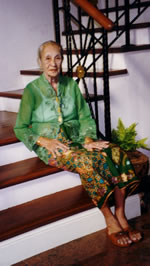
& My Mother, Koh Soon Neo
Kampongs in Singapore
The word kampong is Malay, meaning village. Like the Peranakan culture, kampongs are definitely an endangered species in Singapore. These settlements of attap-roofed houses designed to let air pass through to lessen the heat caused by the humidity of the tropical sun are near extinction. The last of these, Kampong Buangkok, still remaining in 2009 will soon meet its fate.
Although the palm-thatched huts gave colonial Singapore its exotic look and were fodder to tourists in search of ethnicity, those who lived in them had to cope with centipedes that fell out of old attap and leaky roofs during the monsoons. As the kampongs or villages were located in rural areas, it generally meant that the long arms of electricity and the rivers of piped water did not reach them. So life in a kampong was challenging.
Kampong Potong Pasir
Our village was one such kampong in the 1950s though not quite rural, only about 10 miles or so out of town, Upper Serangoon Road acting as one border and Bradell Road on the other. The Kallang River used to cut a broad swathe to the inner reaches of the village feeding vegetable farms and small holdings. The name of the village was derived from the cutting of sand-hills; potong means to cut in Malay and pasir is sand. The sand quarries created four ponds that were a distinctive feature of Kampong Potong Pasir. In the 1970s when the village was razed to the ground in preparation for the building of Housing Development Board (HDB) blocks of flats, these ponds were filled. The river was the cause of massive floods in the village.
My parents and siblings were already living in the village when I was born. We did not leave until the 1970s the same time that the bull-dozers came in to uproot the palm trees and the wooden attap-thatched houses.
There was a sense of community in the village, people talked and helped each other; doors were never closed till darkness fell. Children of different races, Malay, Indians, Chinese and Eurasians played with each other in the sandy yard. Everyone celebrated everyone else’s New Year. Everyone also knew of everyone else’s affairs! The houses were built so close to each other that if you sat on your doorstep and stretched your legs out, your feet reached the opposite neighbour’s doorstep. Narrow paths, called lorongs, ran like a maze through the village.
Life in Kampong Potong Pasir was high drama. You never know when you would get drinking water. In the dry seasons, our wells dried up and we had to collect rain-water in pails and kerosene tins in order to wash. For drinking, we had a stand-pipe some distance away or had to wait for the water trucks to arrive. When generators eventually were installed to supply electricity, drama ensued when they broke down and we had to scramble for candles, carbide or hurricane lamps! Jambans or outhouses were my bete noir, unpalatable to describe with rats and cockroaches climbing all over your feet where you squatted. And when the buckets had not been collected for days, going to the toilet was a test of your capacity to hold your breath!
My Mother, Koh Soon Neo

Mak at 84. Her name was Koh Soon Neo
Born into a wealthy Peranakan family in Malacca, where she had servants to attend to her every need and where she played music and embroidered, she underwent a massive change of fortune and ended up marrying my father who was a clerk. Yet she was always regal and went about her chores as if everything she did was noble. She was beautiful within and without. Even old age, wrinkles and eventually Alzheimer could not destroy her innate goodness and beauty.
Without her intercession, I would be uneducated. My father felt that education was not for girls. She defied him and sold nonya kueh, i.e Peranakan cakes, to pay for my school fees and uniform so that I could go to school. My book, Frog Under A Coconut Shell was written to honour her. Fortunately she held the book before she passed on but she could not recognise herself in the wedding photo on the cover of the book by then. She left a legacy of hard work, perseverance and joy to her children. Except for my youngest brother who died at 24, all my brothers and sisters have waded out of the mire of poverty.
For me, yoga is a living practice, every single hour, every single day in my ordinary everyday life.
View more...

View Photos and look up upcoming events here

Listen to podcasts & interviews here
